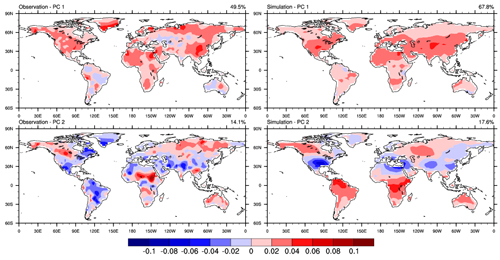Is decadal climate prediction efficient via a two-tiered approach?
Date:2015-01-20
Multidecadal variability (MDV) in the climate system has been a difficult issue in regional decadal climate prediction. While MDV is not simulated well by current coupled climate models, a two-tiered approach became an alternative, i.e., predicting decadal climate by using atmospheric general circulation models (AGCMs) forced by predicted sea surface temperature (SST). However, even if SST is known, how much climate variability over the lands can be simulated by the SST-forced AGCMs remained an open question.
Recently, GAO Lihao and YAN Zhongwei from the Institute of Atmospheric Physics, Beijing, and Xiaowei QUAN from the University of Colorado, Boulder addressed this issue and they estimated that MDV accounts for 30-40% of variance of long-term variations in land surface air temperature (SAT) for most regions according to observations during the last century, thus quantifying the importance of MDV in regional decadal climate prediction. They then analyzed 40 AGCMs simulations forced by observed SST and found that AGCMs can reproduce the main features of observed MDV in land SAT. In particular, two major modes of MDV in global land SAT can be well reproduced, which are closely related to the well-known Atlantic Multidecadal Oscillation (AMO) and Pacific Decadal Oscillation (PDO), respectively (figures below). Moreover, they found that the SST-forced signals are more profound in some regions (such as parts of East Asia, North America, and northern Eurasia) than elsewhere. An implication is that a two-tiered approach of regional decadal climate prediction could be more efficient for these regions than the others. These results are undoubtedly helpful for understanding the role of SST in generating climate variability over the lands and for developing methods of regional climate prediction.

Fig. 1 The 1st Principal Component (PC1, left) and the 2nd (PC2, right) timeseries of MDVin observed (red) and simulated (green) land SAT, compared with MDV of the AMO and PDO index series (black), respectively.

Fig. 2 Geographical patterns of the first two PCs of MDV in observed (left) and simulated (right) land SAT.
References:
Gao L. H., Z. W. Yan, X. W. Quan, 2015: Observed and SST-forced Multidecadal Variability in Global Land Surface Air Temperature. Climate Dynamics,44(1) 359-369. doi: 10.1007/s00382-014-2121-9.
Download: http://www.springerlink.com/openurl.asp?genre=article&id=doi:10.1007/s00382-014-2121-9
Contact: Dr. YAN Zhongwei, yzw@tea.ac.cn
